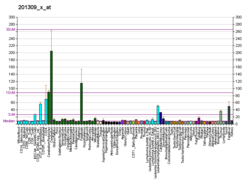| NREP |
|---|
|
| Identifiers |
|---|
| Aliases | NREP, C5orf13, D4S114, P311, PRO1873, PTZ17, SEZ17, neuronal regeneration related protein |
|---|
| External IDs | OMIM: 607332; MGI: 99444; HomoloGene: 70874; GeneCards: NREP; OMA:NREP - orthologs |
|---|
| Gene location (Human) |
|---|
 | | Chr. | Chromosome 5 (human)[1] |
|---|
| | Band | 5q22.1 | Start | 111,662,621 bp[1] |
|---|
| End | 111,997,464 bp[1] |
|---|
|
| Gene location (Mouse) |
|---|
 | | Chr. | Chromosome 18 (mouse)[2] |
|---|
| | Band | 18|18 B1 | Start | 33,570,072 bp[2] |
|---|
| End | 33,597,082 bp[2] |
|---|
|
| RNA expression pattern |
|---|
| Bgee | | Human | Mouse (ortholog) |
|---|
| Top expressed in | - paraflocculus of cerebellum
- ganglionic eminence
- tibia
- ventricular zone
- right hemisphere of cerebellum
- pons
- Brodmann area 46
- cartilage tissue
- frontal pole
- tendon of biceps brachii
|
| | Top expressed in | - external carotid artery
- vestibular sensory epithelium
- cerebellar vermis
- Rostral migratory stream
- Gonadal ridge
- lobe of cerebellum
- fossa
- barrel cortex
- condyle
- internal carotid artery
|
| | More reference expression data |
|
|---|
| BioGPS | 

 | | More reference expression data |
|
|---|
|
| Gene ontology |
|---|
| Molecular function | | | Cellular component | | | Biological process | - regulation of neuron differentiation
- axon regeneration
- regulation of transforming growth factor beta receptor signaling pathway
| | Sources:Amigo / QuickGO |
|
| Orthologs |
|---|
| Species | Human | Mouse |
|---|
| Entrez | | |
|---|
| Ensembl | | |
|---|
| UniProt | | |
|---|
| RefSeq (mRNA) | NM_001142474
NM_001142475
NM_001142476
NM_001142477
NM_001142478
|
|---|
NM_001142479
NM_001142480
NM_001142481
NM_001142482
NM_001142483
NM_004772 |
| |
|---|
NM_001109988
NM_001109989
NM_001267717
NM_053078 |
|
|---|
| RefSeq (protein) | NP_001135946
NP_001135947
NP_001135948
NP_001135949
NP_001135950
|
|---|
NP_001135951
NP_001135952
NP_001135953
NP_001135954
NP_001135955
NP_004763 |
| |
|---|
NP_001103458
NP_001103459
NP_001254646
NP_444308 |
|
|---|
| Location (UCSC) | Chr 5: 111.66 – 112 Mb | Chr 18: 33.57 – 33.6 Mb |
|---|
| PubMed search | [3] | [4] |
|---|
|
| Wikidata |
| View/Edit Human | View/Edit Mouse |
|



















